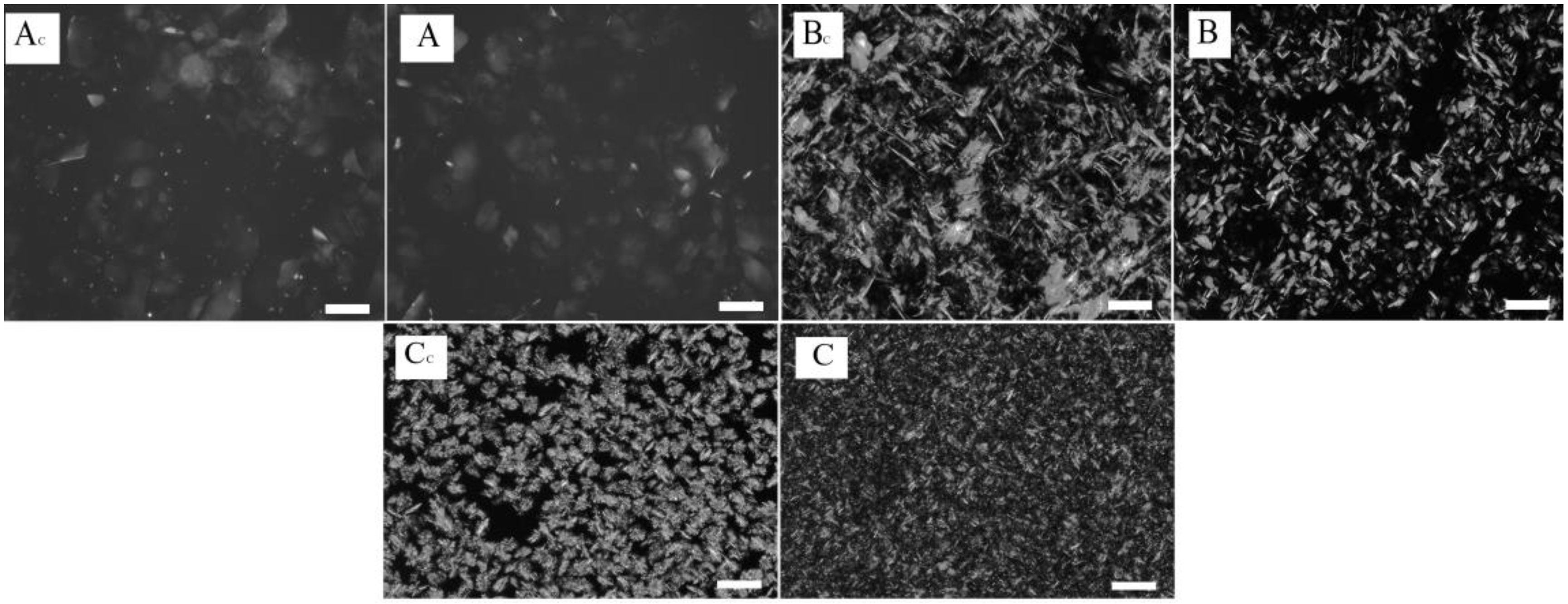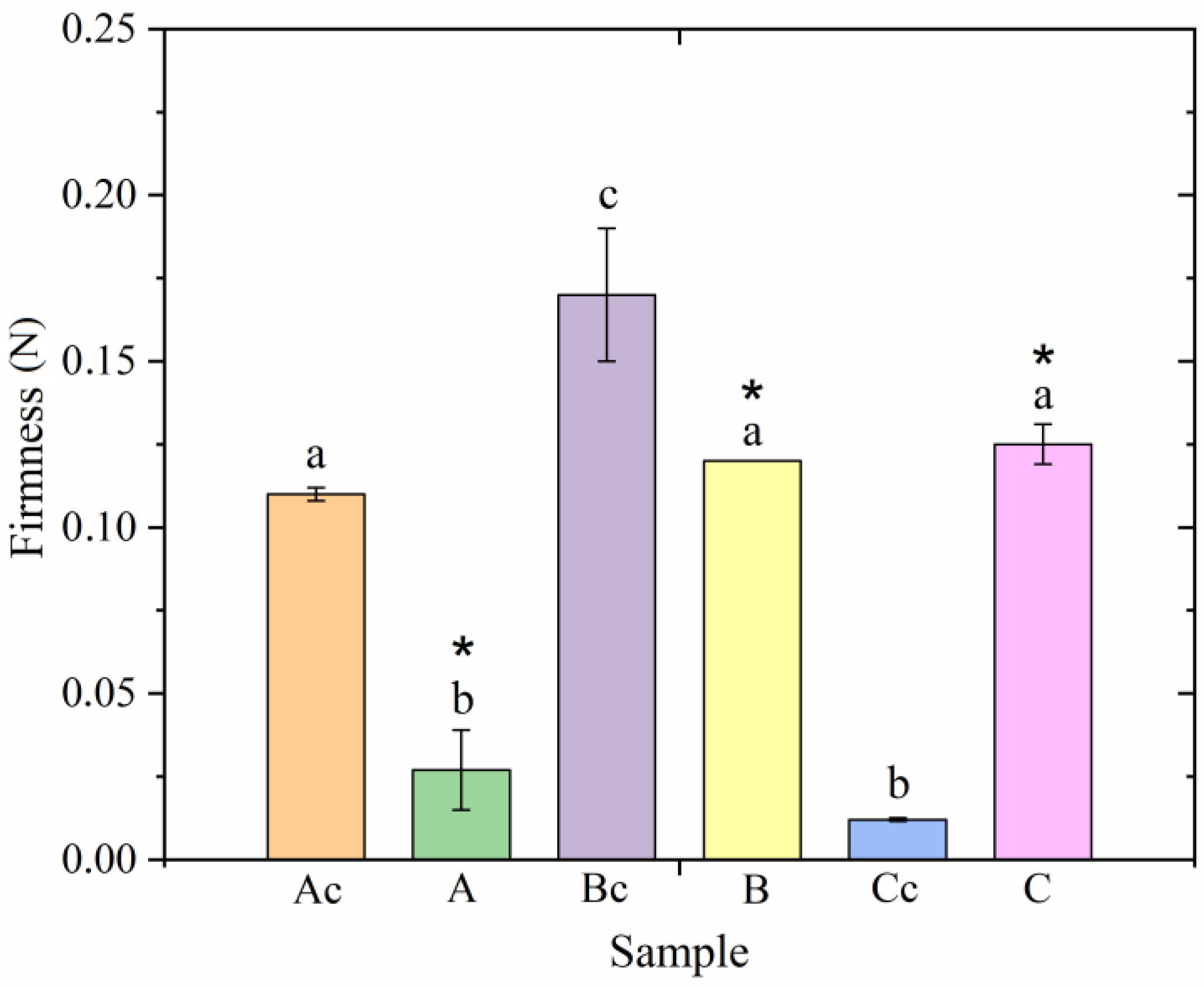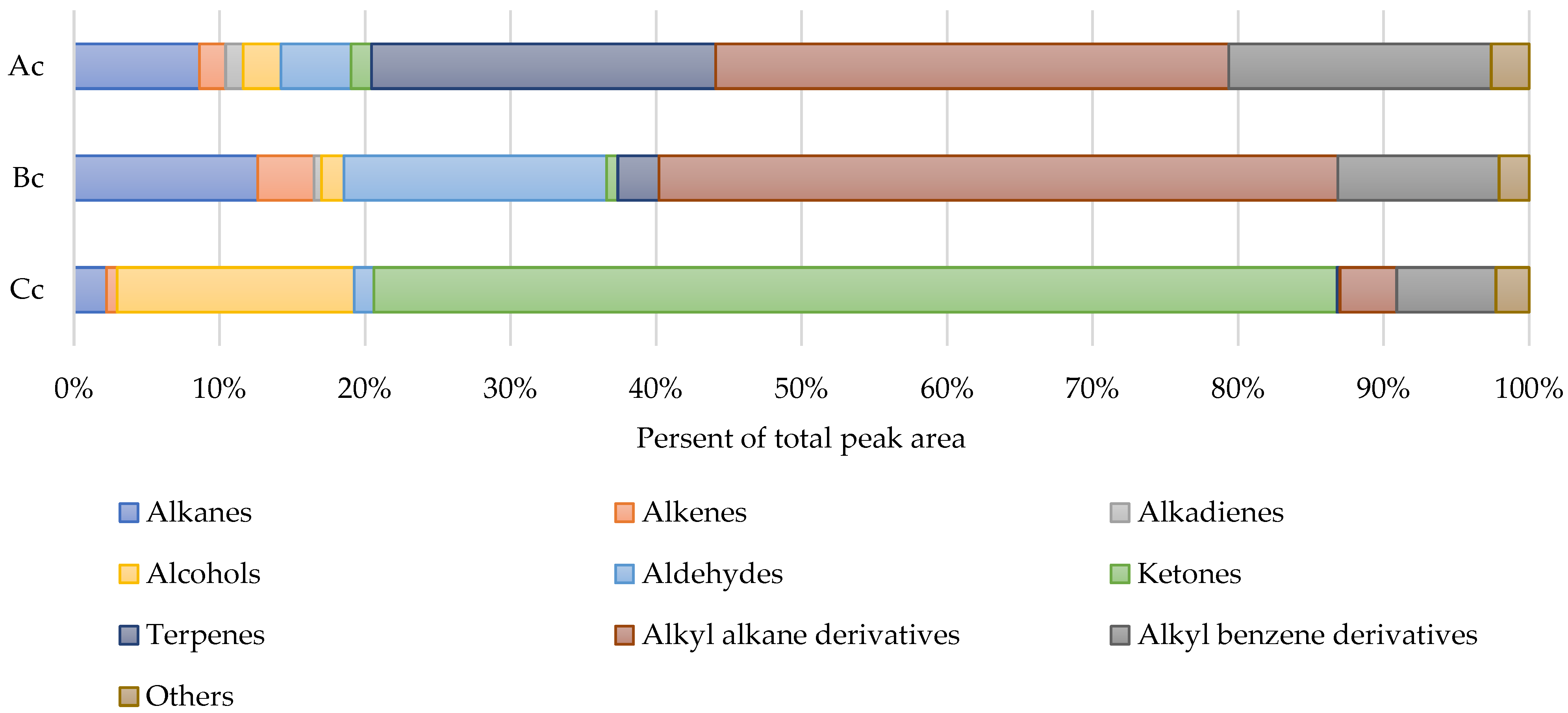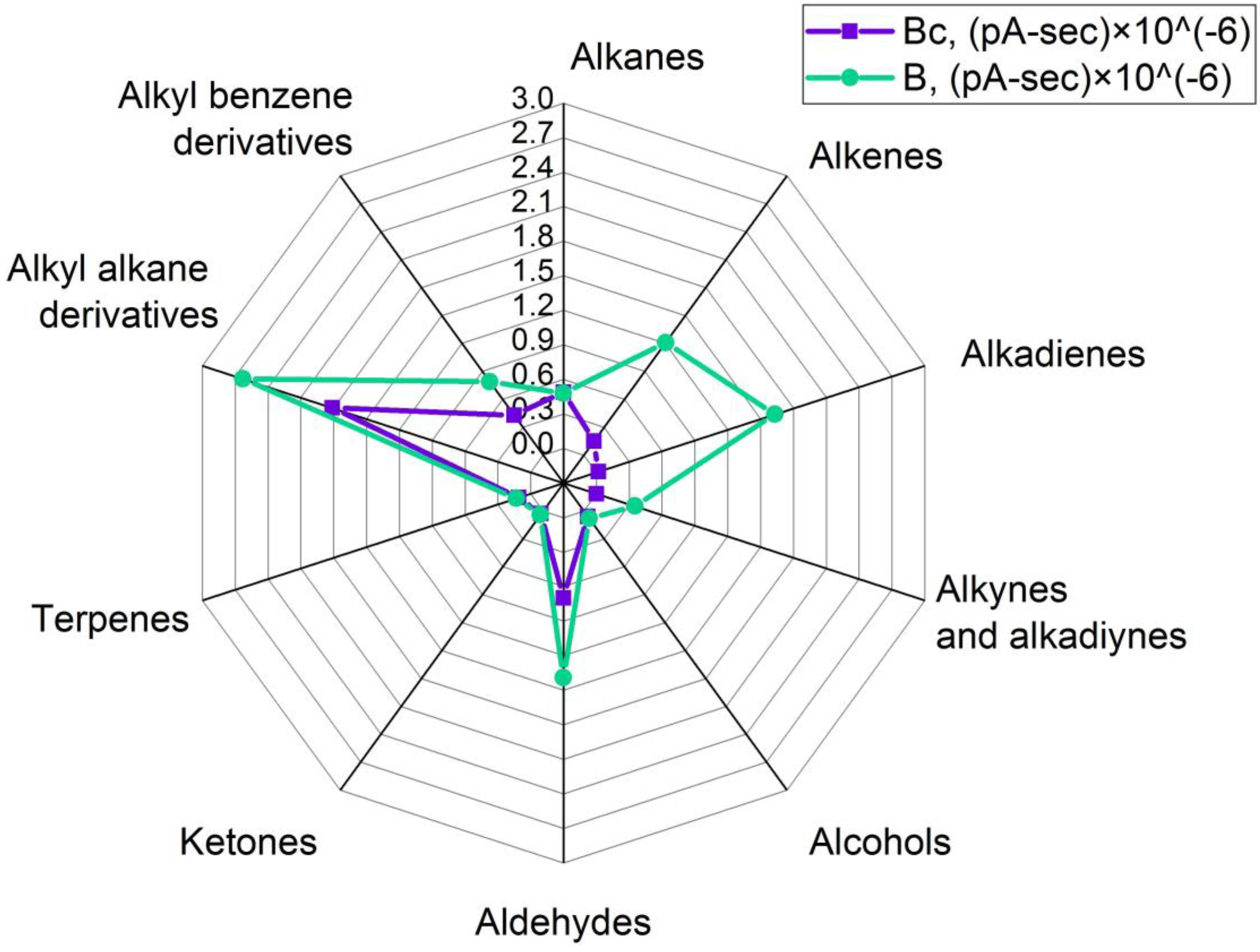Analysis of Oleogel Volatile Profile Formation under Ultrasonic Treatment
Abstract
:1. Introduction
2. Results and Discussion
2.1. Microscopy
2.2. Texture Properties
2.3. Volatile Organic Compounds
3. Conclusions
4. Materials and Methods
4.1. Materials
4.2. Oleogel Preparation
4.3. Oleogel Analysis
4.3.1. Microscopy
4.3.2. Texture Analysis
4.3.3. Determination of Volatile Organic Compounds
- Volatiles extraction and HS-SPME conditions
- About 6–7 g of each oleogel was placed into a 20 mL head-space vial so that the amount of the sample did not exceed half of the vial. Then it was sealed with a screw cap with a blue PTFE/white silicone septa. Then a GERSTEL MPS Multipurpose Sampler (GERSTEL GmbH & Co. KG, Mülheim, Germany) was used for the HS-SPME procedure under Maestro 1 software control (version 1.5.4.23/3.5). The MPS was equipped with a 50/30 μm divinylbenzene/carboxen/polydimethylsiloxane (DVB/CAR/PDMS) fiber (57298-U, Supelco, Bellefonte, PA, USA) used to extract the VOCs of the oleogels. The automated sample preparation procedure included fiber conditioning at 250 °C for 30 min, sample incubation in the agitation module at 50 °C for 15 min with permanent agitation, exposition of the fiber over an stirring sample at 50 °C for 40 min, and desorption in the injector at 255 °C for 5 min.
- GC-MS/FID conditions
- GC-MS analysis was carried out on a 7890A GC equipped with a quadrupole mass spectrometer 7000 and a flame ionization detector (Agilent Technologies, Santa Clara, CA, USA). Supelcowax 10 (bonded polyethylene glycol) capillary column 60 m × 530 μm × 1.0 μm was used. A Deans switch after the column was used to bifurcate a mobile phase with volatiles: one part was directed to the FID and another one to the MSD. The oven temperature was set as follows: 35 °C for 5 min, then increased up to 220 °C at a rate of 4 °C/min, isotherm 50 min (the total analysis time was 101 min). A helium carrier gas (purity ≥ 99.999%) was used at a linear velocity of 2.8 mL/min in a splitless mode. MS was operated under an electron impact (EI) ionization mode of 70 eV. The data acquisition was set within a range of 35–400 m/z. The ion source, quadrupole analyzer, transfer line, and FID temperatures were set at 230 °C, 150 °C, 260 °C, and 250 °C, respectively.
- Identification of volatiles
- All peaks with a height of more than 3 baseline’s standard deviations were tried to be identified. The MS-spectrum of each peak was compared to the appropriate MS-spectra available in the libraries of the NIST Mass Spectral Search Program for the NIST/EPA/NIH Mass Spectral Library Version 2.0 g. Matching criteria with value higher than 700 was taken as the first identification criteria. The second criteria was Kovats indices calculated using a C8-C20 n-alkanes series and compared to available Kovats indices for polar columns at the PubChem (https://pubchem.ncbi.nlm.nih.gov/, accessed on 25 September 2023) and the NistWebbook (https://webbook.nist.gov/chemistry/name-ser/, accessed on 25 September 2023) resources. Also, the PubChem database, the Good Scents Company Information System, and available literature were used to correspond identified volatiles and their aroma (http://www.thegoodscentscompany.com/index.html, accessed on 25 September 2023).
4.4. Statistical Analysis
Supplementary Materials
Author Contributions
Funding
Institutional Review Board Statement
Informed Consent Statement
Data Availability Statement
Conflicts of Interest
References
- Pehlivanoğlu, H.; Demirci, M.; Toker, O.S.; Konar, N.; Karasu, S.; Sagdic, O. Oleogels, a promising structured oil for decreasing saturated fatty acid concentrations: Production and food-based applications. Crit. Rev. Food Sci. Nutr. 2018, 58, 1330–1341. [Google Scholar] [CrossRef] [PubMed]
- Frolova, Y.V.; Kochetkova, A.A.; Sobolev, R.V.; Vorobyeva, V.M.; Kodentsova, V.M. Oleogels as prospective nutritional ingredients of lipid nature. Vopr. Pitan. 2021, 90, 64–73. [Google Scholar] [CrossRef]
- Silva, P.M.; Cerqueira, M.A.; Martins, A.J.; Fasolin, L.H.; Cunha, R.L.; Vicente, A.A. Oleogels and bigels as alternatives to saturated fats: A review on their application by the food industry. J. Am. Oil Chem. Soc. 2022, 99, 911–923. [Google Scholar] [CrossRef]
- Caggiula, A.W.; Mustad, V.A. Effects of dietary fat and fatty acids on coronary artery disease risk and total and lipoprotein cholesterol concentrations: Epidemiologic studies. Am. J. Clin. Nutr. 1997, 65, 1597–1610. [Google Scholar] [CrossRef] [PubMed]
- Zhuang, P.; Zhang, Y.; He, W.; Chen, X.; Chen, J.; He, L.; Mao, L.; Wu, F.; Jiao, J. Dietary fats in relation to total and cause-specific mortality in a prospective cohort of 521 120 individuals with 16 years of follow-up. Circ. Res. 2019, 124, 757–768. [Google Scholar] [CrossRef] [PubMed]
- Yılmaz, E.; Toksöz, B. Flaxseed oil-wax oleogels replacement for tallowfat in sucuk samples provided higher concentrations of polyunsaturated fatty acids and aromatic volatiles. Meat Sci. 2022, 192, 108875. [Google Scholar] [CrossRef] [PubMed]
- Guo, J.; Cui, L.; Meng, Z. Oleogels/emulsion gels as novel saturated fat replacers in meat products: A review. Food Hydrocoll. 2023, 137, 108313. [Google Scholar] [CrossRef]
- Li, L.; Liu, G.; Bogojevic, O.; Pedersen, J.N.; Guo, Z. Edible oleogels as solid fat alternatives: Composition and oleogelation mechanism implications. Compr. Rev. Food Sci. Food Saf. 2022, 21, 2077–2104. [Google Scholar] [CrossRef]
- Aguilar, F.; Autrup, H.; Barlow, S.; Castle, L.; Crebelli, R.; Dekant, W.; Engel, K.H.; Gontard, N.; Gott, D.; Grilli, S.; et al. Beeswax (E 901) as a glazing agent and as carrier for flavours scientific opinion of the panel on food additives, flavourings, processing aids and materials in contact with food (AFC). EFSA J. 2007, 645, 1–28. [Google Scholar]
- Doan, C.D.; To, C.M.; De Vrieze, M.; Lynen, F.; Danthine, S.; Brown, A.; Dewettinck, K.; Patel, A.R. Chemical profiling of the major components in natural waxes to elucidate their role in liquid oil structuring. Food Chem. 2017, 214, 717–725. [Google Scholar] [CrossRef]
- Sarkisyan, V.; Sobolev, R.; Frolova, Y.; Malinkin, A.; Makarenko, M.; Kochetkova, A. Beeswax fractions used as potential oil gelling agents. J. Am. Oil Chem. Soc. 2021, 98, 281–296. [Google Scholar] [CrossRef]
- Sobolev, R.; Frolova, Y.; Sarkisyan, V.; Makarenko, M.; Kochetkova, A. Effect of beeswax and combinations of its fractions on the oxidative stability of oleogels. Food Biosci. 2022, 48, 101744. [Google Scholar] [CrossRef]
- Sivakanthan, S.; Fawzia, S.; Madhujith, T.; Karim, A. Synergistic effects of oleogelators in tailoring the properties of oleogels: A review. Compr. Rev. Food Sci. Food Saf. 2022, 21, 3507–3539. [Google Scholar] [CrossRef] [PubMed]
- Ghorghi, Z.B.; Yeganehzad, S.; Hesarinejad, M.A.; Faezian, A.; Kutsenkova, V.; Gao, Z.; Nishinari, K.; Nepovinnykh, N. Fabrication of novel hybrid gel based on beeswax oleogel: Application in the compound chocolate formulation. Food Hydrocoll. 2023, 140, 108599. [Google Scholar] [CrossRef]
- Airoldi, R.; da Silva, T.L.T.; Ract, J.N.R.; Foguel, A.; Colleran, H.L.; Ibrahim, S.A.; da Silva, R.C. Potential use of carnauba wax oleogel to replace saturated fat in ice cream. J. Am. Oil Chem. Soc. 2022, 99, 1085–1099. [Google Scholar] [CrossRef]
- Okuro, P.K.; Tavernier, I.; Sintang, M.D.B.; Skirtach, A.G.; Vicente, A.A.; Dewettinck, K.; Cunha, R.L. Synergistic interactions between lecithin and fruit wax in oleogel formation. Food Funct. 2018, 9, 1755–1767. [Google Scholar] [CrossRef] [PubMed]
- Holey, S.A.; Sekhar, K.P.; Mishra, S.S.; Kanjilal, S.; Nayak, R.R. Effect of oil unsaturation and wax composition on stability, properties and food applicability of oleogels. J. Am. Oil Chem. Soc. 2021, 98, 1189–1203. [Google Scholar] [CrossRef]
- Giacomozzi, A.S.; Palla, C.A.; Carrín, M.E.; Martini, S. Physical properties of monoglycerides oleogels modified by concentration, cooling rate, and high-intensity ultrasound. J. Food Sci. 2019, 84, 2549–2561. [Google Scholar] [CrossRef]
- Welti-Chanes, J.; Morales-de la Peña, M.; Jacobo-Velázquez, D.A.; Martín-Belloso, O. Opportunities and challenges of ultrasound for food processing: An industry point of view. In Ultrasound: Advances for Food Processing and Preservation; Academic Press: Cambridge, MA, USA, 2017; pp. 457–497. [Google Scholar]
- Frolova, Y.; Sarkisyan, V.; Sobolev, R.; Kochetkova, A. Ultrasonic Treatment of Food Colloidal Systems Containing Oleogels: A Review. Gels 2022, 8, 801. [Google Scholar] [CrossRef]
- Bui, A.T.H.; Cozzolino, D.; Zisu, B.; Chandrapala, J. Effects of high and low frequency ultrasound on the production of volatile compounds in milk and milk products—A review. J. Dairy Res. 2020, 87, 501–512. [Google Scholar]
- Pingret, D.; Durand, G.; Fabiano-Tixier, A.S.; Rockenbauer, A.; Ginies, C.; Chemat, F. Degradation of edible oil during food processing by ultrasound: Electron paramagnetic resonance, physicochemical, and sensory appreciation. J. Agric. Food Chem. 2012, 60, 7761–7768. [Google Scholar] [CrossRef] [PubMed]
- Da Silva, T.L.T.; Arellano, D.B.; Martini, S. Use of high-intensity ultrasound to change the physical properties of oleogels and emulsion gels. J. Am. Oil Chem. Soc. 2019, 96, 681–691. [Google Scholar] [CrossRef]
- Yao, Y.; Zhou, H.; Liu, W.; Li, C.; Wang, S. The effect of cooling rate on the microstructure and macroscopic properties of rice bran wax oleogels. J. Oleo Sci. 2021, 70, 135–143. [Google Scholar] [CrossRef] [PubMed]
- Blake, A.I.; Marangoni, A.G. The effect of shear on the microstructure and oil binding capacity of wax crystal networks. Food Biophys. 2015, 10, 403–415. [Google Scholar] [CrossRef]
- Trujillo-Ramírez, D.; Reyes, I.; Lobato-Calleros, C.; Vernon-Carter, E.J.; Alvarez-Ramirez, J. Chia seed oil-candelilla wax oleogels structural features and viscoelasticity are enhanced by annealing. LWT 2022, 153, 112433. [Google Scholar] [CrossRef]
- Jana, S.; Martini, S. Effect of high-intensity ultrasound and cooling rate on the crystallization behavior of beeswax in edible oils. J. Agric. Food Chem. 2014, 62, 10192–10202. [Google Scholar] [CrossRef]
- Rumayor-Escobar, A.; Morales-de la Peña, M.; de la Rosa-Millán, J.; Arredondo-Ochoa, T.; Dibildox-Alvarado, E.; Tejada-Ortigoza, V. Effect of high intensity ultrasound on soybean and avocado oleogels’ structure and stability. Food Struct. 2023, 36, 100315. [Google Scholar] [CrossRef]
- Da Silva, T.L.T.; Danthine, S. Effect of high-intensity ultrasound on the oleogelation and physical properties of high melting point monoglycerides and triglycerides oleogels. J. Food Sci. 2021, 86, 343–356. [Google Scholar] [CrossRef]
- Sarkisyan, V.; Frolova, Y.; Sobolev, R.; Kochetkova, A. On the Role of Beeswax Components in the Regulation of Sunflower Oil Oleogel Properties. Food Biophys. 2023, 18, 262–272. [Google Scholar] [CrossRef]
- Tavernier, I.; Doan, C.D.; Van de Walle, D.; Danthine, S.; Rimaux, T.; Dewettinck, K. Sequential crystallization of high and low melting waxes to improve oil structuring in wax-based oleogels. RSC Adv. 2017, 7, 12113–12125. [Google Scholar] [CrossRef]
- Hepburn, H.R.; Pirk, C.W.W.; Duangphakdee, O. Chapter 16: The Chemistry of Beeswax. In Honeybee Nests: Composition, Structure, Function; Springer: Berlin/Heidelberg, Germany, 2014; Volume 978, pp. 341–365. [Google Scholar]
- Maia, M.; Nunes, F.M. Authentication of beeswax (Apis mellifera) by high-temperature gas chromatography and chemometric analysis. Food Chem. 2013, 136, 961–968. [Google Scholar] [CrossRef] [PubMed]
- Sawicki, T.; Starowicz, M.; Kłębukowska, L.; Hanus, P. The profile of polyphenolic compounds, contents of total phenolics and flavonoids, and antioxidant and antimicrobial properties of bee products. Molecules 2022, 27, 1301. [Google Scholar] [CrossRef] [PubMed]
- Breheret, S.; Talou, T.; Rapior, S.; Bessière, J.M. (Z)-and (E)-1, 3-Octadiene-New major volatile compounds in mushroom aromas (Basidiomycotina). J. Essent. Oil Res. 1998, 10, 716–718. [Google Scholar] [CrossRef]
- Evans, C.D.; Moser, H.A.; List, G.R. Odor and flavor responses to additives in edible oils. J. Am. Oil Chem. Soc. 1971, 48, 495–498. [Google Scholar] [CrossRef]
- Lattuati-Derieux, A.; Thao, S.; Langlois, J.; Regert, M. First results on headspace-solid phase microextraction-gas chromatography/mass spectrometry of volatile organic compounds emitted by wax objects in museums. J. Chromatogr. A 2008, 1187, 239–249. [Google Scholar] [CrossRef] [PubMed]
- Starowicz, M.; Hanus, P.; Lamparski, G.; Sawicki, T. Characterizing the volatile and sensory profiles, and sugar content of beeswax, beebread, bee pollen, and honey. Molecules 2021, 26, 3410. [Google Scholar] [CrossRef] [PubMed]
- Regert, M.; Colinart, S.; Degrand, L.; Decavallas, O. Chemical alteration and use of beeswax through time: Accelerated ageing tests and analysis of archaeological samples from various environmental contexts. Archaeometry 2001, 43, 549–569. [Google Scholar] [CrossRef]
- Ahn, D.U.; Olson, D.G.; Jo, C.; Love, J.; Jin, S.K. Volatiles production and lipid oxidation in irradiated cooked sausage as related to packaging and storage. J. Food Sci. 1999, 64, 226–229. [Google Scholar] [CrossRef]
- Riener, J.; Noci, F.; Cronin, D.A.; Morgan, D.J.; Lyng, J.G. Characterisation of volatile compounds generated in milk by high intensity ultrasound. Int. Dairy J. 2009, 19, 269–272. [Google Scholar] [CrossRef]
- Sfakianakis, P.; Tzia, C. Flavour profiling by gas chromatography–mass spectrometry and sensory analysis of yoghurt derived from ultrasonicated and homogenised milk. Int. Dairy J. 2017, 75, 120–128. [Google Scholar] [CrossRef]
- Chemat, F.; Grondin, I.; Costes, P.; Moutoussamy, L.; Sing, A.S.C.; Smadja, J. High power ultrasound effects on lipid oxidation of refined sunflower oil. Ultrason. Sonochem. 2004, 11, 281–285. [Google Scholar] [CrossRef]







Disclaimer/Publisher’s Note: The statements, opinions and data contained in all publications are solely those of the individual author(s) and contributor(s) and not of MDPI and/or the editor(s). MDPI and/or the editor(s) disclaim responsibility for any injury to people or property resulting from any ideas, methods, instructions or products referred to in the content. |
© 2023 by the authors. Licensee MDPI, Basel, Switzerland. This article is an open access article distributed under the terms and conditions of the Creative Commons Attribution (CC BY) license (https://creativecommons.org/licenses/by/4.0/).
Share and Cite
Frolova, Y.; Makarenko, M.; Kochetkova, A. Analysis of Oleogel Volatile Profile Formation under Ultrasonic Treatment. Gels 2023, 9, 823. https://doi.org/10.3390/gels9100823
Frolova Y, Makarenko M, Kochetkova A. Analysis of Oleogel Volatile Profile Formation under Ultrasonic Treatment. Gels. 2023; 9(10):823. https://doi.org/10.3390/gels9100823
Chicago/Turabian StyleFrolova, Yuliya, Mariia Makarenko, and Alla Kochetkova. 2023. "Analysis of Oleogel Volatile Profile Formation under Ultrasonic Treatment" Gels 9, no. 10: 823. https://doi.org/10.3390/gels9100823
APA StyleFrolova, Y., Makarenko, M., & Kochetkova, A. (2023). Analysis of Oleogel Volatile Profile Formation under Ultrasonic Treatment. Gels, 9(10), 823. https://doi.org/10.3390/gels9100823






